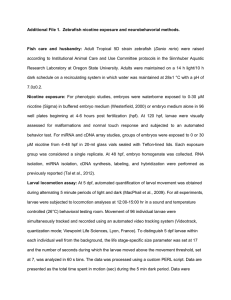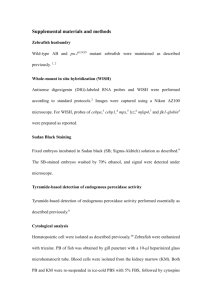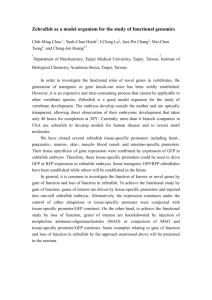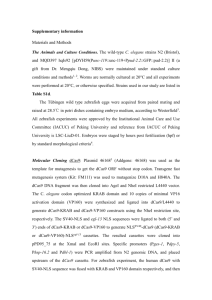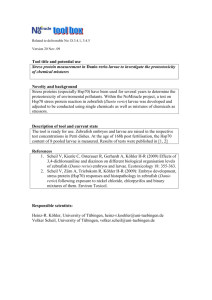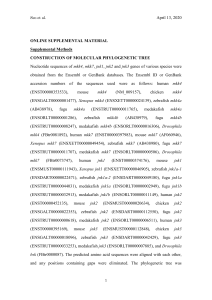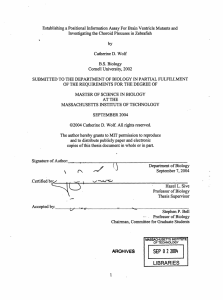Supplementary materials and methods (doc 112K)
advertisement
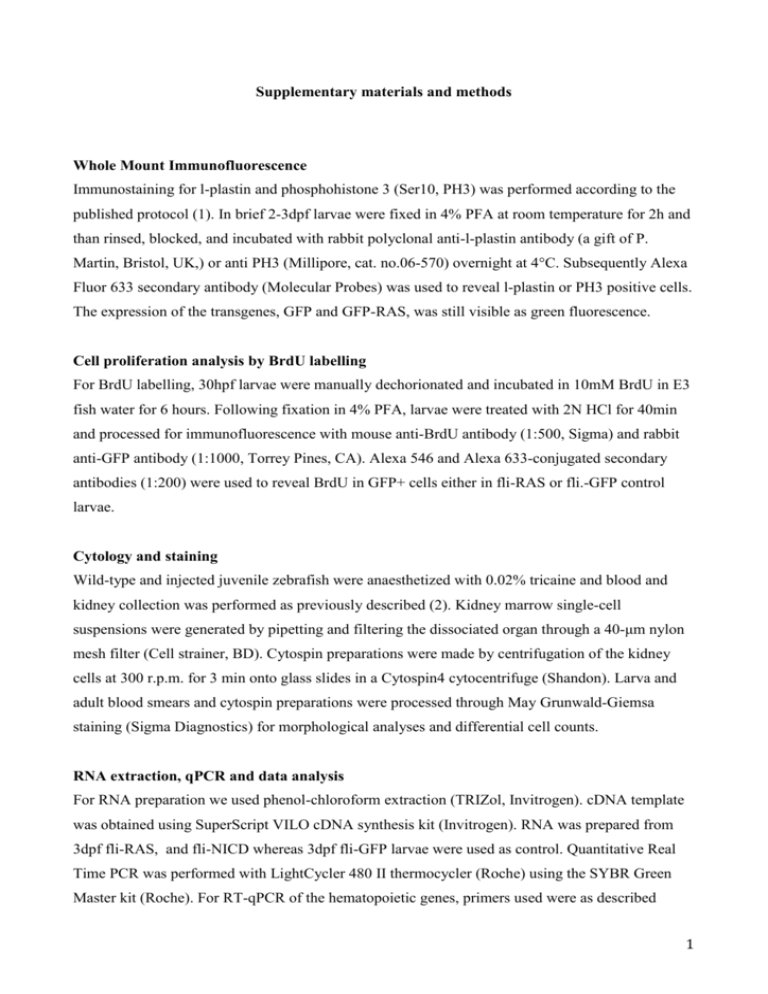
Supplementary materials and methods Whole Mount Immunofluorescence Immunostaining for l-plastin and phosphohistone 3 (Ser10, PH3) was performed according to the published protocol (1). In brief 2-3dpf larvae were fixed in 4% PFA at room temperature for 2h and than rinsed, blocked, and incubated with rabbit polyclonal anti-l-plastin antibody (a gift of P. Martin, Bristol, UK,) or anti PH3 (Millipore, cat. no.06-570) overnight at 4°C. Subsequently Alexa Fluor 633 secondary antibody (Molecular Probes) was used to reveal l-plastin or PH3 positive cells. The expression of the transgenes, GFP and GFP-RAS, was still visible as green fluorescence. Cell proliferation analysis by BrdU labelling For BrdU labelling, 30hpf larvae were manually dechorionated and incubated in 10mM BrdU in E3 fish water for 6 hours. Following fixation in 4% PFA, larvae were treated with 2N HCl for 40min and processed for immunofluorescence with mouse anti-BrdU antibody (1:500, Sigma) and rabbit anti-GFP antibody (1:1000, Torrey Pines, CA). Alexa 546 and Alexa 633-conjugated secondary antibodies (1:200) were used to reveal BrdU in GFP+ cells either in fli-RAS or fli.-GFP control larvae. Cytology and staining Wild-type and injected juvenile zebrafish were anaesthetized with 0.02% tricaine and blood and kidney collection was performed as previously described (2). Kidney marrow single-cell suspensions were generated by pipetting and filtering the dissociated organ through a 40-μm nylon mesh filter (Cell strainer, BD). Cytospin preparations were made by centrifugation of the kidney cells at 300 r.p.m. for 3 min onto glass slides in a Cytospin4 cytocentrifuge (Shandon). Larva and adult blood smears and cytospin preparations were processed through May Grunwald-Giemsa staining (Sigma Diagnostics) for morphological analyses and differential cell counts. RNA extraction, qPCR and data analysis For RNA preparation we used phenol-chloroform extraction (TRIZol, Invitrogen). cDNA template was obtained using SuperScript VILO cDNA synthesis kit (Invitrogen). RNA was prepared from 3dpf fli-RAS, and fli-NICD whereas 3dpf fli-GFP larvae were used as control. Quantitative Real Time PCR was performed with LightCycler 480 II thermocycler (Roche) using the SYBR Green Master kit (Roche). For RT-qPCR of the hematopoietic genes, primers used were as described 1 before (3). All the other primers were designed using Primer 3 and are shown in supplementary Table III. For all samples the expression level was analysed using Q-Gene software, which expresses data as mean normalized expression. Relative genes expression in fli-RAS or fli-NICD embryos compared to whole fli-GFP age match embryos, was determined by calculating ∆∆ CT values after normalization to beta-actin. RNA-Seq and statistical analysis Total RNA from 3dpf wild type, fli-RAS and fli-NICD embryos was prepared by TRIzol reagent (Invitrogen) and RNAeasy kit (Qiagen) and quantified via Nanodrop (Thermo Fisher Scientific Inc.). 10 μg of total RNA was used to construct sequencing libraries using the Illumina TruSeq RNA Sample Prep Kit. Libraries were sequenced with on an Illumina HiSeq 2000 with read lengths of 2×51 nt. The Illumina pipeline was used for image analysis, demupliplexing and base-calling. Raw sequencing reads were analysed using the CLC bio Assembly Cell version 3.2 (CLC bio, Aarhus, Denmark). Low quality basec-calls were removed, and reads were aligned to cDNA sequences predicted by Ensembl based on the Zv9 zebrafish genome assembly (www.ensembl.org). Read counts were quantified and normalized to yield RPKM expression values (4) Log2 fold changes were calculated using the DESeq package for Bioconductor using the variance stabilization option (5). Imaging of zebrafish embryos and larvae For both live imaging studies and fixed samples, larvae were mounted on slides in 1.5% low melting agarose (Sigma). Images were collected using a Leica SP2 Confocal Microscope or Nikon S100 stereomicroscope equipped with epi-fluorescence and multiple filters. For time-lapse imaging zebrafish were prepared as previously described(6). Imaging was carried out also using a Leica SP5 confocal microscope. Conversion of Kaede Kaede was converted from green to red using a Leica SP5 confocal microscope and a 20x objective. Using the ROI function the respective tissue was illuminated with UV light (405nm) for 2min. Images of converted embryos were taken at 73hpf and 5dpf using a Leica DMI 6000B microscope. Image rendering Images were rendered using Volocity 5, Adobe Photoshop CS4, Image J and Quicktime Pro. 2 Histology and immunofluorescence Fli-RAS 5dpf larva and juvenile fish and age-matched control were killed by anaesthetic overdose and fixed for 2h at room temperature in 4% paraformaldehyde. After over night incubation in 10% and 20% sucrose, sample were transferred to optimum cutting temperature (OCT; Sakura Finetek, Torrance, CA). Cryostat sections (16 um thick) were air-dried and incubated over night with rabbit polyclonal anti l-plastin (1:500) or PH3 (1:1000) and mouse anti GFP (1:1000). Secondary antibodies conjugated with Alexa 488, Alexa 546 and Alexa 633 were from Molecular Probes (Carlsbad, CA). 4,6-Diamidino-2-phenylindole, DAPI (1:10000) counter stain was carried out on all sections. Apoptotic assay by TUNEL assay For TUNEL (terminal deoxynucleotidyl transferase dUTP nick end labeling) assay, PFA-fixed embryos were permeabilized by treatment with at –20°C and then stained using In situ Cell Death Detection Kit, POD (Roche) according to the manufacturer’s instructions. Whole Mount In situ Hybridization Whole-mount in situ hybridization for c-myb (ZFIN ID: ZDB-GENE-991110-14) was performed as previously described (7). 1. Redd MJ, Kelly G, Dunn G, Way M, Martin P. Imaging macrophage chemotaxis in vivo: studies of microtubule function in zebrafish wound inflammation. Cell Motil Cytoskeleton 2006 Jul; 63(7): 415-422. 2. Traver D, Paw BH, Poss KD, Penberthy WT, Lin S, Zon LI. Transplantation and in vivo imaging of multilineage engraftment in zebrafish bloodless mutants. Nat Immunol 2003 Dec; 4(12): 1238-1246. 3. Bertrand JY, Traver D. Hematopoietic cell development in the zebrafish embryo. Curr Opin Hematol 2009 Jul; 16(4): 243-248. 4. Mortazavi A, Williams BA, McCue K, Schaeffer L, Wold B. Mapping and quantifying mammalian transcriptomes by RNA-Seq. Nat Methods 2008 Jul; 5(7): 621-628. 5. Anders S, Huber W. Differential expression analysis for sequence count data. Genome Biol 2010; 11(10): R106. 3 6. Distel M, Koster RW. In vivo time-lapse imaging of zebrafish embryonic development. CSH Protoc 2007; 2007: pdb prot4816. 7. Thisse C, Thisse B, Schilling TF, Postlethwait JH. Structure of the zebrafish snail1 gene and its expression in wild-type, spadetail and no tail mutant embryos. Development 1993; 119: 1203–1215 4
